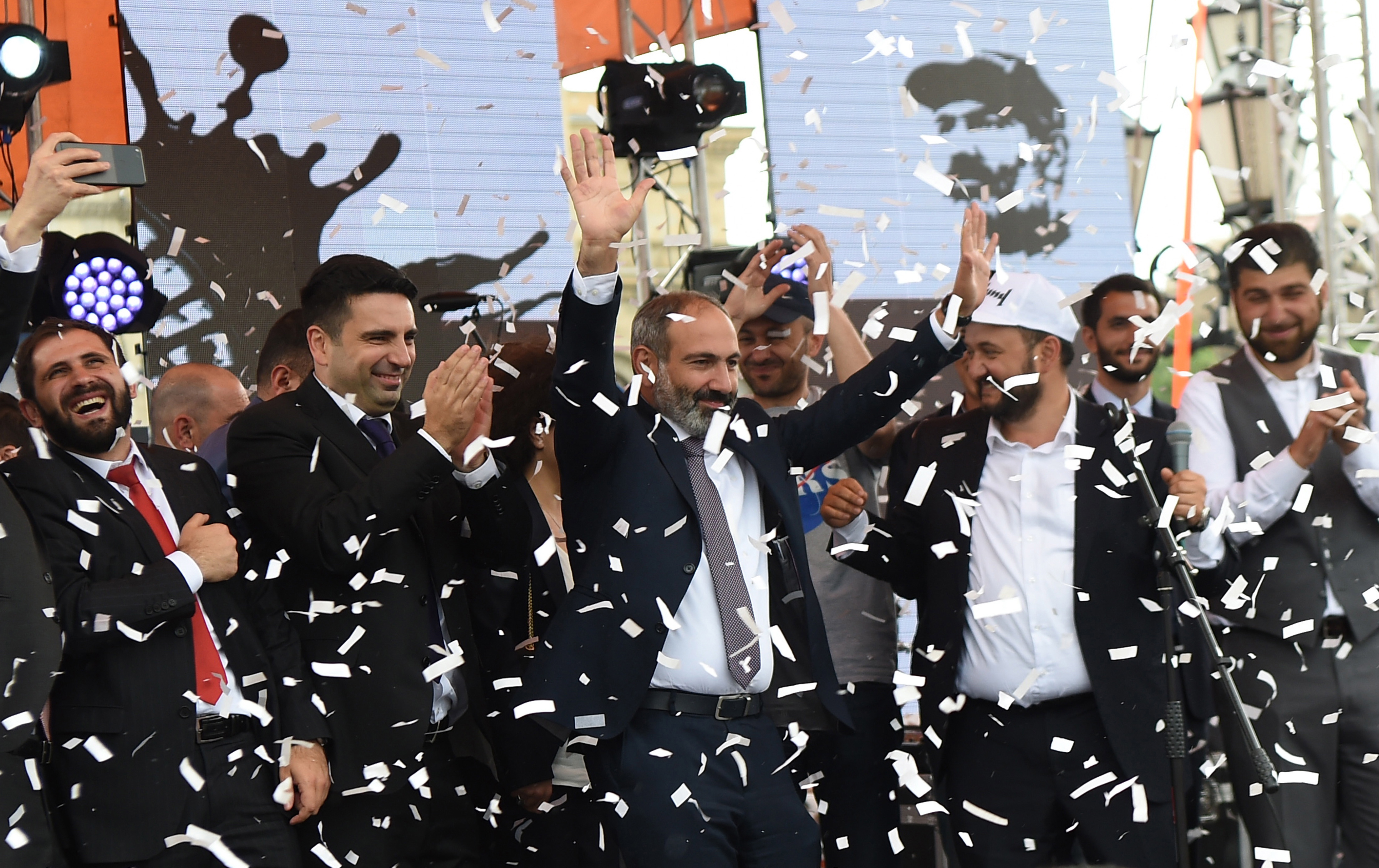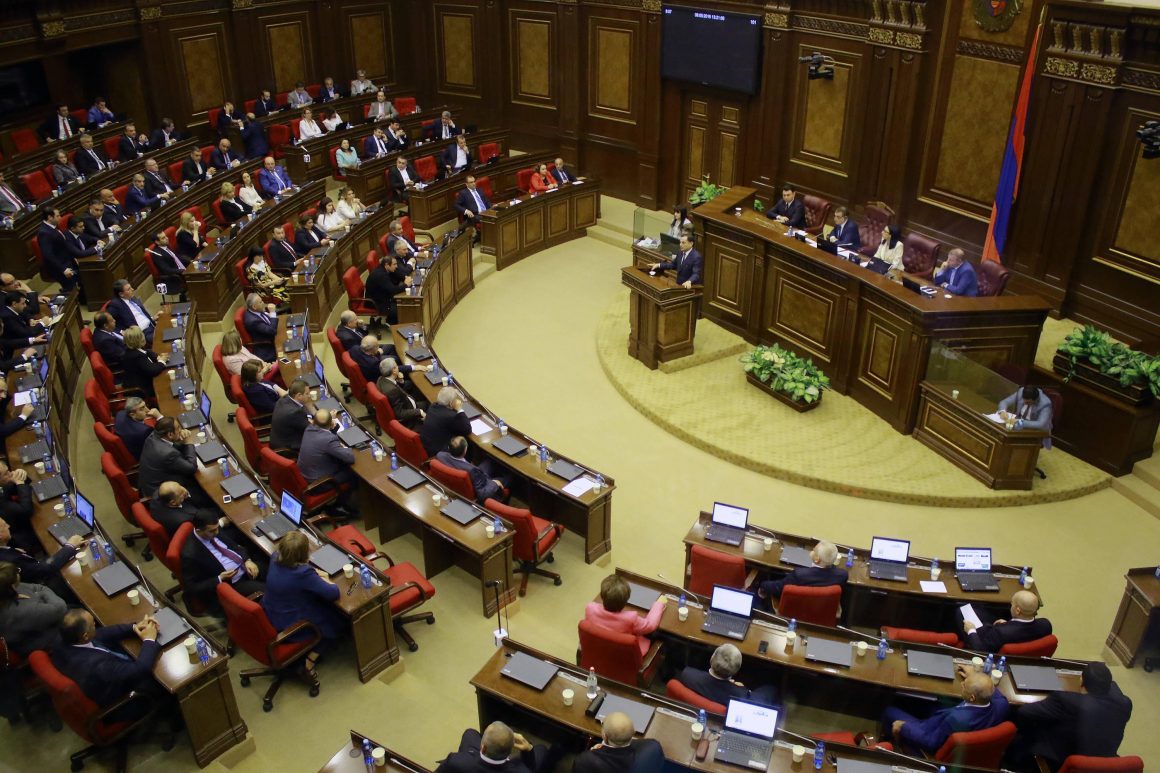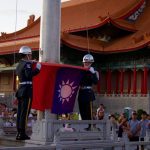THE WARSAW INSTITUTE REVIEW
Date: 5 July 2019 Author: Mateusz Kubiak
Armenia: Pashinyan’s first year
One of the most critical turning points in modern Armenian history took place a year ago. In the spring, its citizens took to the streets in massive numbers and took power away from the Republican Party – a political vehicle which had stayed in power for two decades. The newly elected government’s agenda is a combination of serious reforms with an alliance with Russia. This approach, however, results in mistrust on the part of Moscow. Armenia’s authorities have also activated dialogue with Azerbaijan on the issue of Nagorno-Karabakh. This does not however mean that an agreement on this issue should be expected.
 ARMENIAN OPPOSITION LEADER AND NEWLY-ELECTED PRIME MINISTER NIKOL PASHINYAN (C) CELEBRATES WITH HIS SUPPORTERS IN THE REPUBLIC SQUARE IN YEREVAN, ARMENIA, 08 MAY 2018. © HAYK BAGHDASARYAN (PAP/EPA)
ARMENIAN OPPOSITION LEADER AND NEWLY-ELECTED PRIME MINISTER NIKOL PASHINYAN (C) CELEBRATES WITH HIS SUPPORTERS IN THE REPUBLIC SQUARE IN YEREVAN, ARMENIA, 08 MAY 2018. © HAYK BAGHDASARYAN (PAP/EPA)One year has passed since the mass protests that led to the resignation of Serzh Sargsyan, who has been ruling the country for a decade (2008–2018), and the seizure of power by the leader of street demonstrations, Nikol Pashinyan. As a direct consequence of these events, snap elections were called and held on December 9, 2018, which finally completed the process of changing power and allowed the 20-year monopoly of the Republican Party of Armenia (HHK) over the country to be broken up.
The new team led by Nikol Pashinyan proclaims the need for a thorough reform of the country, while also advocating a policy of continuity in the international arena. Although the government was favored with confidence (both in the country, winning a constitutional majority in elections, and abroad – Armenia was even recognized as the “country of the year” by the opinion-forming The Economist), it is already starting to be accountable for its actions. What has Pashinyan achieved so far, and what does he propose for relations with Russia and the still smoldering conflict over Nagorno-Karabakh?
The creeping revolution
The direct cause of last year’s revolution was a kind of “constitutional maneuver” of Serzh Sargsyan – who was then about to end his second (and the last possible) presidential term. He was the first to transfer powers of the Head of State to the Prime Minister. In April 2018 – contrary to previous announcements – he was nominated to the office of the Head of Government. This was the ultimate reason why crowds of people took to the streets of Yerevan and other cities. It should also be emphasized that revolutionary moods have been growing in Armenia for a long time.
In fact, Armenia has been in a permanent crisis throughout the entire period of its current statehood. The reasons for this situation are both the conflict over Nagorno-Karabakh with Azerbaijan, as well as the extreme oligarchization of political and economic life and the resulting social stratification. Taking into account only on the last decade of the HHK government (or rather of the ‘Karabakh clan’ controlling the party), it can be pointed out that the percentage of people living below the poverty line remained at the level of 30–35%, while the official level of unemployment was within the range of 15–20%. A solution for the citizens has become economic emigration, which is now the case for one in three families. Armenia has been depopulating year by year, losing up to 2% of the population annually, and remaining dependent on money transfers from Russia (which, depending on the year, amounted even to several percents of the country’s GDP).
The natural consequence of the difficult economic situation, corruption, and oligarchization of the country was social discontent. The latter even increased after the events of March 2008, when post-election protests were bloodily suppressed, and ten people died. In retrospect, these events can be seen as a turning point in the dynamic development of Armenia’s civil society. Each year, more and more grassroots opposition actions were being organized in the country – first concerning local and then also national issues. The participants of these, often successful, protests were more and more convinced that civic activity makes sense, the proof of which became mass demonstrations against rising energy prices in 2015 (the so-called Electric Yerevan). It seems that it was this situation (together with the economic and political factors mentioned above) that resulted in the mass mobilization of society in the spring of 2018 and the removal of the HHK and the Karabakh clan from power.
As a result of last year’s protests, Nikol Pashinyan was appointed Prime Minister in May 2018. However, due to his poor representation in the National Assembly at that time, he was forced to act according to the votes of parties associated with the previous system (the main coalition member was, for example, the oligarch Gagik Tsarukyan). Although Pashinyan had, at that time, already made a full announcement of planned reforms, the actions taken in 2018 were somewhat temporary and focused primarily on the fight against the corruption and oligarchic arrangements of the previous system. It was clear that early elections were necessary for a thorough reform of the country, which would confirm the social mandate of the new government. Finally, they were held in December 2018, and as a result, the newly Pashinyan’s political vehicle – ‘My Step Alliance’ – obtained a constitutional majority.
 ARMENIAN ARTILLERY POSITION OF THE SELF-DEFENSE ARMY OF NAGORNO-KARABAKH IN MARTAKERT, NAGORNO-KARABAKH REPUBLIC, 03 APRIL 2016. © VAHRAM BAGHDASARYAN (PAP/EPA)
ARMENIAN ARTILLERY POSITION OF THE SELF-DEFENSE ARMY OF NAGORNO-KARABAKH IN MARTAKERT, NAGORNO-KARABAKH REPUBLIC, 03 APRIL 2016. © VAHRAM BAGHDASARYAN (PAP/EPA)Distrust of Moscow
From the Western point of view, the fundamental question was whether and to what extent the change of power in Armenia would influence the shape of the foreign policy of the country and, above all, the nature of its cooperation with Russia. Today, from this year’s perspective, it can be seen thatalthough there has not been a significant redefinition in the Armenian international strategy, the authorities in Yerevan seem to be working towards a “soft emancipation” from Moscow’s domination. What is important, these efforts to reduce Russian influence are not so much the result of a different vision of relations in the region, but rather of an ambitious reform agenda in Armenia itself, reckoning with previous governments (linked to the Kremlin), and a desire to balance relations with the “Big Brother”.
A convenient example of the presented dependence is cooperation in the gas sector, where Gazprom Armenia, controlled by Russians, remains an exclusive monopolist for the transmission and distribution of the raw material (apart from Gazprom Armenia, only the state-owned combined heat and power plant in Yerevan has a license to import it). Already in mid-2018, the new Armenian authorities signaled to Russia the need to reduce the gas tariffs, which was then confirmed by a specially appointed commission, while at the same time the state authorities also launched a procedure for tax abuses in the monopoly company. As it seems, in response to this there was a rumor in the media that the Russians were going to drastically (by as much as 1/3) raise the price of gas supplied from 2019 (by the end of 2018 it was 150 USD/thousandm3 “at the border”)[1]. Finally, the terms and conditions of raw material deliveries were agreed at the end of December last year (i.e. when the existing contract expired) and despite Armenian efforts, they include a 10% increase to 165 USD/thousandm3. Although negotiations on this issue are still ongoing – Nikol Pashinyan declares that this increase in import prices will not affect end-users due to the reduction of Gazprom Armenia’s tariffs – it is clear that this issue remains a problem in relations with Moscow. What is important, the Russians are suggesting that a possible reduction in Gazprom Armenia’s profits will force a reduction in the country’s investment agenda.
Naturally, the issue of gas prices remains only one of many examples of how the internal agenda of the new authorities affects relations with Moscow. Other factors are both the planned diversification in the energy sector (now also strongly dependent on Russian gas)[2], the fight against informal monopolies and corruption (e.g. shakedowns in the offices of a railway carrier controlled by Russians) and, last but not least, reckoning with Armenia’s previous authorities. In this context, reference should be made in particular to the proceedings against former President Robert Kocharyan and the former commander of the capital city’s garrison, General Yuri Khachaturov, concerning their participation in the events of March 2008. The case is crucial to Armenian–Russian relations because Kocharyan is said to be closely connected (according to reports, even personally) with Vladimir Putin, and Khachaturov was the chairman of The Collective Security Treaty Organization (CSTO), from which he was dismissed at the request of the authorities in Yerevan. It seems that Moscow treated it as a blow to the prestige of the developed CSTO. As a result of all this, Armenian-Russian relations today seem to be characterized by a high degree of mistrust and a kind of a constant tug-of-war as to the extent of Kremlin’s influence over the changes in Armenia.
Intensification of talks about Nagorno-Karabakh
The conflict over Nagorno-Karabakh, which has a very realimpact on the functioning of the Armenian state, remains a fundamental issue for any government, including the one of Nikol Pashinyan. The new authorities are also taking active steps in this area, but it seems that they do not have a real chance of translating it into any more comprehensive agreement with Azerbaijan.
On the one hand, there has been a significant intensification of talks between Yerevan and Baku. As of February, since the change of power in Armenia, four meetings of foreign ministers and three informal meetings of heads of state have been held. It is worth noting that the personal nature of Nikol Pashinyan’s talks with Azerbaijani President Ilham Aliyev (“in the corridors” of international summits) does not mean in this case that these are only fleeting contacts. In January this year, during the Davos conference, the two politicians spoke to each other for about an hour and a half.
The fundamental postulate raised by Nikol Pashinyan is the need to include the so-called Nagorno-Karabakh Republic in the ongoing peace process. Pashinyan argues that as Prime Minister of Armenia, elected by the people of that country, he has no right to represent the Karabakh population. However, this issue seems to be, first and foremost, peripheral to the ongoing negotiations and, most importantly, actuallyunacceptable to the Azerbaijani side.
On the other hand, it is true that the change of power in Armenia did not have the right to influence the social mood in the country with regard to the Nagorno-Karabakh conflict. In this context, it seems that the lack of readiness to make real concessions (in both countries) makes the current authorities in Yerevan very limited in their ability to reach a real compromise. It is noteworthy that as early as January this year, when Pashinyan’s alleged readiness to make concessions to Azerbaijan started to be speculated in public space, the Prime Minister publicly stressed that there was no question of adopting the principle of “territories for peace”, according to which Armenia would be the first to return part of the occupied land around Nagorno-Karabakh to the other side. He also reiterated this declaration in February this year, which was naturally viewed negatively by the Azerbaijani side.
 YEREVAN, MAY 8, 2018. ARMENIAN PARLIAMENT MEMBERS DEBATE BEFORE THE VOTING OF THE NEW PRIME MINISTER IN YEREVAN, ARMENIA. © GEVORG GHAZARYAN (PAP)
YEREVAN, MAY 8, 2018. ARMENIAN PARLIAMENT MEMBERS DEBATE BEFORE THE VOTING OF THE NEW PRIME MINISTER IN YEREVAN, ARMENIA. © GEVORG GHAZARYAN (PAP)In consequence, it can be asked whether, over the past year, apart from the declarations mentioned above and meetings, anything else has happened in the matter of the Nagorno-Karabakh conflict? It seems that, above all, a noticeable calming of the situation on the so-called demarcation line has been observed – for example, not a single death in fighting on either side was reported in both December and January. What is also important is that following one of the meetings in 2018, a direct channel of communication between decision-makers in both countries has been re-established. In a similar spirit, the declaration of the parties to the conflict in January this year was created, in which Armenia and Azerbaijan agreed on ‘the need to take concrete measures to prepare societies for peace.’ This act is unprecedented and can be seen as a success in itself.
Prospects for Nikol Pashinyan
The question is naturally also whether Nikol Pashinyan will remain in power and what difficulties and challenges he will have to face shortly. Of course, today, less than three months after the parliamentary elections that gave Pashinyan a constitutional majority, public confidence in the Prime Minister remains enormous, and this will probably not change much in the perspective of this year. Nevertheless, it seems that already now it is possible to diagnose factors that may become more and more of a problem for Nikol Pashinyan.
Firstly, Nikol Pashinyan’s way of governing is increasingly being criticized: a number of commentators point to the Prime Minister’s inability to cope with criticism from the media or the opposition, or to the questionable competences of some of his closest associates. It also seems that there is a lack of experience on the part of elected politicians from the new ruling camp, which in time may threaten unity within the ruling coalition. Furthermore, one can point to the issue of conflict of interest in the case of Pashinyan himself, whose wife decided not to resign from the post of Editor-in-Chief of the Haykakan Zhamanak newspaper (it was founded years ago by Nikol Pashinyan).
Secondly, it should be stressed that the situation of the current government is not simple. Although the country is experiencing economic growth, it is facing demographic collapse, significant social stratification, and decades of neglect and abuse in many segments of the state. However, it is worth emphasizing that, despite the huge support for the current authorities, selected social groups are already able to protest, as was the case, for example, with the increase in the taxation of Armenian gastronomic establishments. It even seems that street protests (including civil disobedience e.g. by blocking national roads) have become a relatively natural instrument of social participation in today’s Armenia. As a result, if we add to this the potential ease of destabilization of the situation in Armenia (or in the region) by external actors (Azerbaijan, Russia), then it may turn out that in the next few years the government of Nikol Pashinyan may face significant difficulties.
[1]. Although the price of Russian gas imported by Gazprom Armenia amounted to 150 USD/thousandm3, due to the already mentioned internal tariffs, the price for an average end-user in the country was almost twice as high (the exact tariff varies depending on the amount of gas consumed by a given consumer).
[2]. At the same time, steps are also being taken to liberalize the electricity transmission market itself. After the outbreak of protests against rising energy prices in 2015, the Russian company INTER RAO sold its majority stake in the energy distribution network to Moscow and the previous Armenian authorities, oligarch Samvel Karapetyan. Under the 2017 agreement with the Yerevan authorities, Karapetyan was also to manage the state energy transmission network (the highest voltage grid), but the Pashinyan government annulled the agreement in 2018.
All texts published by the Warsaw Institute Foundation may be disseminated on the condition that their origin is credited. Images may not be used without permission.














